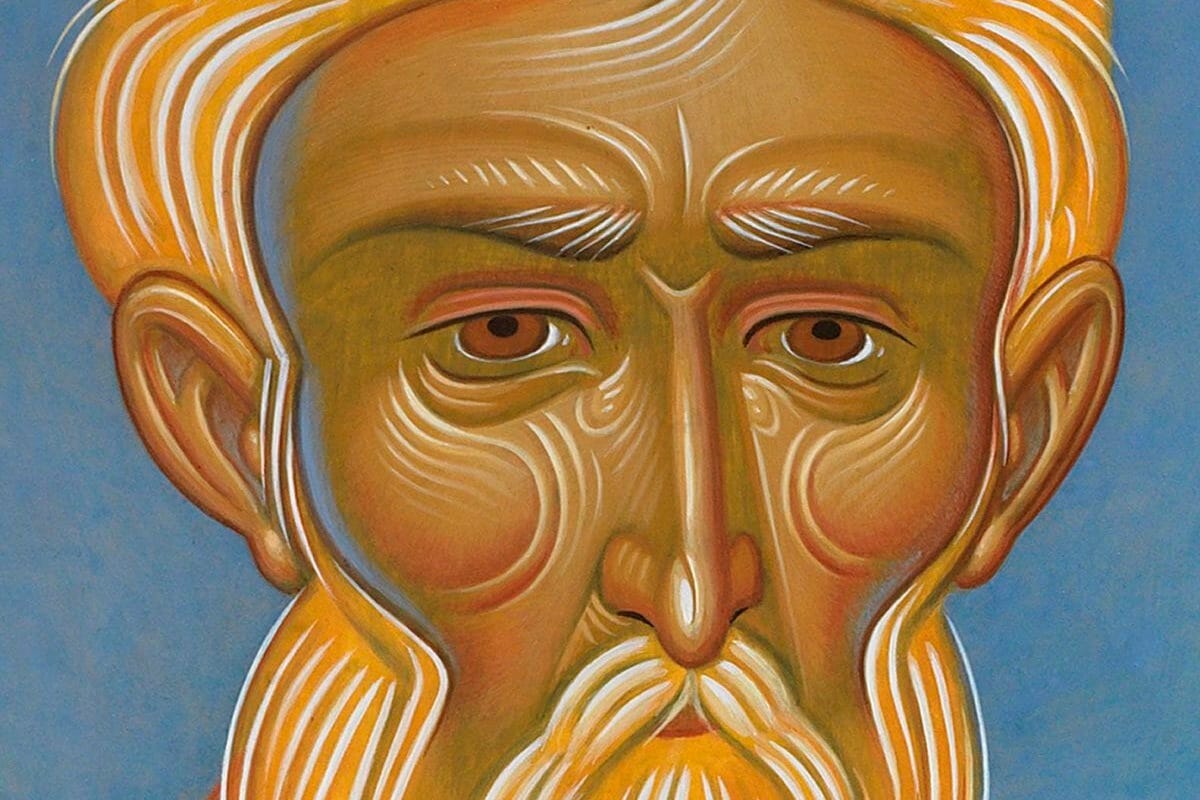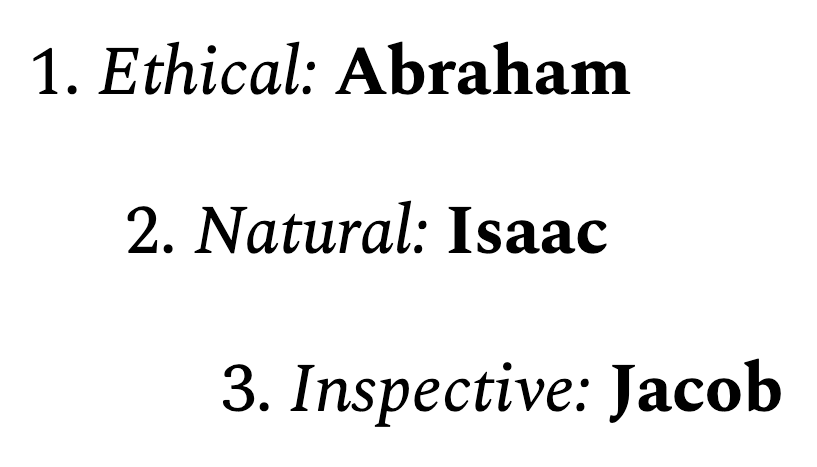Purification, illumination, and perfection
A fractal of triadic ascent — and the six, seven, and eight of the divine octave

When Evagrius of Pontos — a learned disciple of many saints who in the late fourth century sought and received much ascetic wisdom in the Egyptian desert — sets out to write on the topic of practicing the life in Christ, the praxis of the virtues, he places it in context as the first rung in a threefold program. “Christianity,” he opens his Praktikos with authority, “is the doctrine of Christ our Savior, consisting of the practical, the natural, and the theological.”1 He cites this triad also in the prologue to his Chapters on Prayer, as well as later in that work when he opens the section on true prayer saying, “We pursue the virtues” — that’s the practical — “for the sake of the logoi of created beings,” — that’s the natural — “and these we pursue for the sake of the Logos who gave them being, and” — here’s the theological — “he usually manifests himself in the state of prayer.”2
St. Maximus the Confessor, writing in this tradition a few centuries later, commonly adds nouns to those adjectives, calling the three phases practical philosophy, natural contemplation (theoria), and theological mystagogy. They correspond exactly to what St. Dionysius the Areopagite (another profound influence on St. Maximus) calls purification, illumination, and perfection. But whence are these Christian mystics picking up this pattern?

Origen, in the third century, shows us one way that this happens historically. He writes in his introduction to his commentary on the Song of Songs,
The branches of learning by means of which men generally attain to knowledge of things are the three which the Greeks called Ethics, Physics and Enoptics; these we may call respectively moral, natural, and inspective.... That study is called moral which inculcates a seemly manner of life and gives a grounding in habits that incline to virtue. The study called natural is that in which the nature of each single thing is considered; so that nothing in life may be done which is contrary to nature, but everything is assigned to the uses for which the Creator brought it into being. The study called inspective is that by which we go beyond things seen and contemplate something of things divine and heavenly, beholding them with the mind alone, for they are beyond the range of bodily sight.
So he first learns the pattern from Greek paideia, but seeing it in the Hebrew scriptures causes him to rethink its origins, continuing,
It seems to me, then, that all the sages of the Greeks borrowed these ideas from Solomon, who had learned them by the Spirit of God at an age and time long before their own; and that they then put them forward as their own inventions and, by including them in the books of their teachings, left them to be handed down also to those that came after.3
I might also add that their conception of the third stage, “enoptics” or inspective, is vastly inferior to the teaching we find in the depth of Scripture and more explicitly in the Church Fathers. That’s to be expected given their lack of revelation. When St. Gregory of Nyssa, a late fourth-century contemporary of Evagrius, gives a series of homilies on Song of Songs, he reiterates Origen’s teaching on the pattern of the three books of Solomon, but is able to describe the third stage more boldly as a deifying event: “What is described there [in Song of Songs] is an account of a wedding, but what is intellectually discerned is the human soul’s mingling with the Divine.”4 That the pattern endures as threefold even among the pre-Christian pagans is a testimony to the purpose of deification being intrinsic to nature (even if the activity of deification is not). Origin goes on,
But, as we said, Solomon discovered and taught these things by the wisdom that he received from God, before anyone; as it is written: And God gave understanding to Solomon and wisdom exceeding much, and largeness of heart as the sand that is on the seashore. And wisdom was multiplied in him above all the sons of men that were of old, and above all the sages of Egypt [3 Kgdms. 4:29–30]. Wishing, therefore, to distinguish one from another those three branches of learning, which we called general just now — that is, the moral, the natural, and the inspective, and to differentiate between them, Solomon issued them in three books, arranged in their proper order. First, in Proverbs he taught the moral science, putting rules for living into the form of short and pithy maxims, as was fitting. Secondly, he covered the science known as natural in Ecclesiastes; in this, by discussing at length the things of nature, and by distinguishing the useless and vain from the profitable and essential, he counsels us to forsake vanity and cultivate things useful and upright. The inspective science likewise he has propounded in this little book that we have now in hand — that is, the Song of Songs. In this he instils into the soul the love of things divine and heavenly, using for his purpose the figure of the Bride and Bridegroom, and teaches us that communion with God must be attained by the paths of charity and love.5
So what Origen learns to call ethical, natural, and inspective, Evagrius after him calls practical, natural, and theological. St. Dionysius traces the same pattern and calls it purification, illumination, and perfection. Many patterns known intuitively by the Hebrews raised in godliness by the Torah must be discovered more deliberately by the Hellenes, and expressed with greater precision for the correction of their minds. This process of translating revelation into a new culture takes centuries, with many bumps in the road along the way. Origen, and in his train Evagrius, badly misconceive certain macroscopic patterns of creation relative to scriptural revelation, for which cause their writings had eventually to be proscribed by the Church. So many of their insights, however, are so fundamental to the Hellenic mind’s conversion to God, that their influence is maintained through the discerning use of their teachings by the Holy Fathers.
The first work to be called “Philokalia” was a florilegium of orthodox writings culled from Origen’s corpus by Sts. Basil the Great and Gregory the Theologian — both of whom subsequently were teachers of Evagrius. Their discernment unfortunately did not rub off on him, though, as Evagrius accepted and promulgated Origenist errors, giving them new life grounded in the powerful ascetic practices of Egyptian monasticism. Then, the reason St. Maximus the Confessor is so revered today is because he ends the long-lingering era of Origenist influence by straightening the Hellenic contemplative mind according to Orthodoxy once and for all. He achieves this by not scorning the Origenist appetite for speculative knowledge, but fulfilling it with right speculation, humbly marking his limitations, and using Scripture and reason to refute previous errors. From this correction blossoms a long and fruitful spiritual tradition documented by the work we best know as The Philokalia, the eighteenth-century multi-volume anthology of Greek Orthodox spiritual writings which gives more space to St. Maximus the Confessor than to any other single author — and which also includes in the first volume of early Fathers a few orthodox texts by Evagrius.
So Origen, with St. Gregory of Nyssa confirming, sees this triadic pattern of initiation in the three books of Solomon: Proverbs, Ecclesiastes, and Song of Songs. For its historical value, let’s read a little more about Origen’s reasoning there:
This, then, was the reason why this master [Solomon], who was the first to teach men divine philosophy, put at the beginning of his work the Book of Proverbs, in which, as we said, the moral science is propounded — so that when a person has progressed in discernment and behaviour he may pass on thence to train his natural intelligence and, by distinguishing the causes and natures of things, may recognize the vanity of vanities [Eccl. 1:2] that he must forsake, and the lasting and eternal things that he ought to pursue. And so from Proverbs he goes on to Ecclesiastes, who teaches, as we said, that all visible and corporeal things are fleeting and brittle; and surely once the seeker after wisdom has grasped that these things are so, he is bound to spurn and despise them; renouncing the world bag and baggage, if I may put it in that way, he will surely reach out for the things unseen and eternal which, with spiritual meaning verily but under certain metaphors of love, are taught in the Song of Songs.
This book comes last that a man may come to it when his manner of life has been purified, and he has learnt to know the difference between things corruptible and things incorruptible; so that nothing in the metaphors used to describe and represent the love of the Bride for her celestial Bridegroom — that is, of the perfect soul for the Word of God — may cause him to stumble. For, when the soul has completed these studies, by means of which it is cleansed in all its actions and habits and is led to discriminate between natural things, it is competent to proceed to dogmatic and mystical matters, and in this way advances to the contemplation of the Godhead with pure and spiritual love.
To bolster his demonstration, Origen then immediately turns to discussion of what he identifies as another iteration of the pattern:
Keep reading with a 7-day free trial
Subscribe to The Cormac Jones Journal to keep reading this post and get 7 days of free access to the full post archives.



